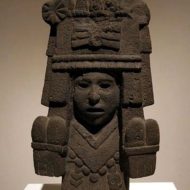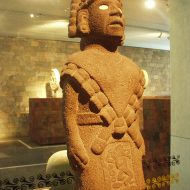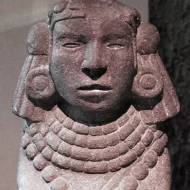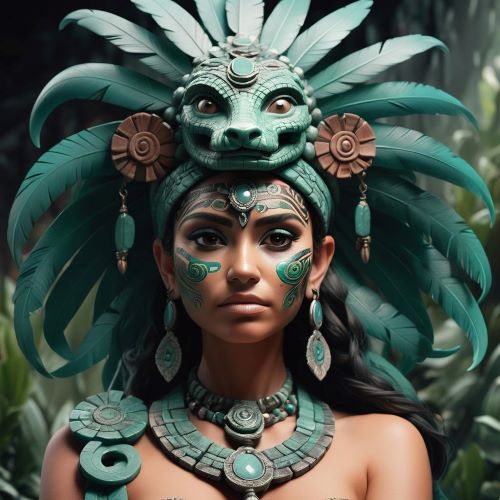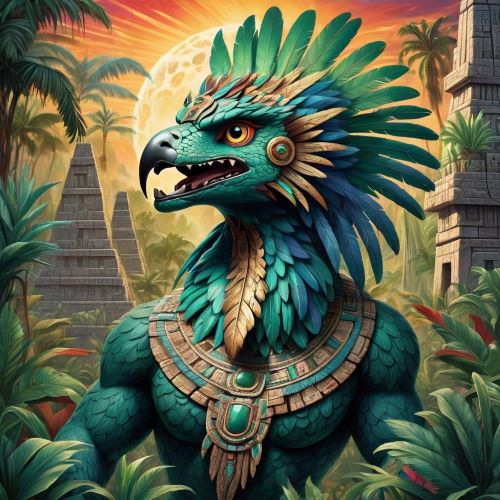Tonantzin : The Virgin Goddess
Listen
At a glance
| Description | |
|---|---|
| Origin | Aztec Mythology |
| Classification | Gods |
| Family Members | N/A |
| Region | Mexico |
| Associated With | Nature |
Tonantzin
Introduction
Tonantzin, a highly esteemed figure in Aztec mythology, is frequently associated with the archetype of the Mother Goddess. The name “Tonantzin” originates from the Nahuatl language, where “to-” signifies “our,” “nān” translates to “mother,” and “-tzin” is an honorific suffix. This appellation is akin to “Our Lady” or “Our Great Mother” in English. In the rich tapestry of Aztec mythology, Tonantzin holds a distinguished place as a multifaceted deity, often venerated as the “Mother Earth” and the “Virgin Goddess.” Her significance in Aztec culture mirrors the reverence accorded to Mother Nature in many contemporary societies.
Physical Traits
Historical texts do not provide specific details about Tonantzin’s physical attributes. As a deity, her appearance is likely to have been open to interpretation and could have varied depending on the particular aspect of the goddess being venerated. Nonetheless, in traditional representations, Tonantzin is characterized as a nurturing and benevolent goddess. Her visual portrayal is a reflection of her role as the embodiment of Earth and fertility. She is often depicted with a tranquil and compassionate visage, underscoring her maternal qualities. Adorned with symbols of fertility, such as ears of maize or corn, she symbolizes the life-sustaining nourishment bestowed by the Earth. Her attire is embellished with an array of flora and blossoms, symbolizing her profound connection to the natural world.
Family
In the realm of Aztec deities, the concept of family is intricate and doesn’t directly parallel human familial bonds. The title “Tonantzin” served to designate the maternal facet of any Aztec goddess. Hence, the notion of her “family” was contingent upon the particular goddess addressed as Tonantzin. Tonantzin’s associations with other deities are exemplified by her link to Coatlicue, who simultaneously serves as her sister and mother. This intricate family dynamic underscores her role as a nurturing and safeguarding figure, entrusted with the care and preservation of the natural world.
Other names
Tonantzin is referred to by different names in Nahuatl, such as Chicōmexōchitl, signifying “Seven Flower,” and Chālchiuhcihuātl, translating to “Emerald/Jade Woman.” These names mirror the diverse aspects and roles of the goddess within Aztec culture. In Aztec mythology, Tonantzin bears several names and titles, each accentuating distinct facets of her character and influence. Among her alternate names is Coatlicue, which conveys “Lady of the Skirt of Snakes,” alluding to her distinctive attire. She is also recognized as Toci, denoting “our grandmother” or “our mother.” These designations exemplify her dual role as a maternal figure and a symbol of the Earth’s life-sustaining abundance.
Powers and Abilities
Tonantzin embodies several vital aspects of life and the natural world, often recognized as “Mother Earth,” the “Goddess of Sustenance,” “Honored Grandmother,” “Snake,” “Bringer of Maize,” and “Mother of Corn.” These appellations signify her perceived powers and abilities, chiefly centered around providing sustenance and serving as the wellspring of life.
Tonantzin’s powers and abilities are intricately interwoven with her role as the Earth goddess. She serves as the fount of fertility and nourishment for the Aztec people, a responsibility that deeply aligns with her inherent abilities. Among her remarkable powers is the capacity to regulate crop growth, ensuring that the land remains rich and productive. This capability was indispensable for the survival of the Aztec civilization, given that agriculture served as the very cornerstone of their society.
In addition to her agricultural role, Tonantzin is also closely linked with maternal protection. She diligently watches over her children, the Aztec people, offering them guidance and safeguarding them from harm, underscoring her role as a benevolent and protective deity.
Modern Day Influence
The enduring influence of Tonantzin reaches into modern times, particularly through the prism of the Virgin of Guadalupe, a prominent figure in Mexican Catholicism. The Basilica of Guadalupe, situated atop the Tepeyac hill, where once the temple of Tonantzin stood, has emerged as one of Mexico’s most significant religious edifices. The syncretism of the Virgin of Guadalupe with Tonantzin at this hallowed site exemplifies the profound impact of Tonantzin in contemporary culture.
Legend has it that in 1531, the Virgin Mary appeared to Juan Diego, an indigenous peasant, on the sacred Tepeyac hill, which was previously dedicated to Tonantzin. During this apparition, the Virgin conversed with Juan Diego in Nahuatl, the Aztec language, and left an image of herself imprinted on his tilma, a traditional Mexican cloak.
The image on the tilma remarkably resembles the traditional portrayal of Tonantzin, featuring dark skin, a compassionate countenance, and a robe bedecked with flowers. This fusion of Catholicism with indigenous beliefs enabled the indigenous populace to preserve their connection to Tonantzin, a central figure in their culture for centuries, while also embracing the new religion introduced by the Spanish.
Presently, the Basilica of Our Lady of Guadalupe, constructed on the very spot of this apparition, stands as one of the world’s most frequented Catholic shrines. Pilgrims from across the globe converge here to pay homage to the Virgin of Guadalupe, and her image permeates Mexican culture. This vividly illustrates the enduring influence of Tonantzin and her remarkable ability to adapt and persist throughout the ages.
Beyond religious contexts, Tonantzin’s impact extends into art, literature, and activism. Her symbolism is frequently invoked in works that seek to reconnect with indigenous heritage and underscore the significance of environmental conservation. Numerous indigenous movements draw inspiration from her as a symbol of tenacity and the indomitable spirit of indigenous peoples.
Related Images
Frequently Asked Questions
What is lorem Ipsum?
I am text block. Click edit button to change this text. Lorem ipsum dolor sit amet, consectetur adipiscing elit. Ut elit tellus, luctus nec ullamcorper mattis, pulvinar dapibus leo.
What is lorem Ipsum?
I am text block. Click edit button to change this text. Lorem ipsum dolor sit amet, consectetur adipiscing elit. Ut elit tellus, luctus nec ullamcorper mattis, pulvinar dapibus leo.
What is lorem Ipsum?
I am text block. Click edit button to change this text. Lorem ipsum dolor sit amet, consectetur adipiscing elit. Ut elit tellus, luctus nec ullamcorper mattis, pulvinar dapibus leo.
What is lorem Ipsum?
I am text block. Click edit button to change this text. Lorem ipsum dolor sit amet, consectetur adipiscing elit. Ut elit tellus, luctus nec ullamcorper mattis, pulvinar dapibus leo.
What is lorem Ipsum?
I am text block. Click edit button to change this text. Lorem ipsum dolor sit amet, consectetur adipiscing elit. Ut elit tellus, luctus nec ullamcorper mattis, pulvinar dapibus leo.

